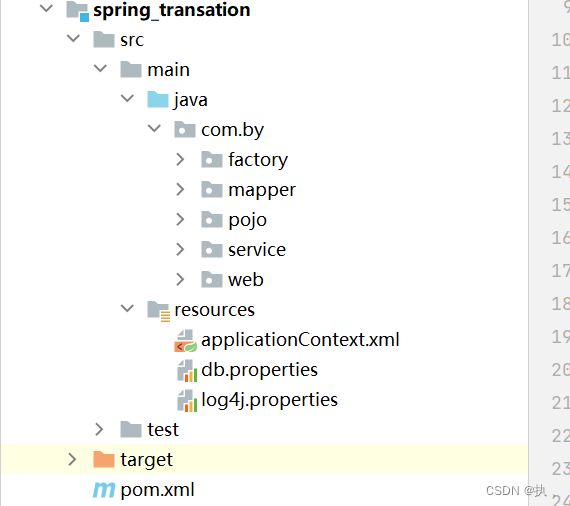Spring事务控制
1.事务介绍
1.1什么是事务?
当你需要一次执行多条SQL语句时,可以使用事务。通俗一点说,如果这几条SQL语句全部执行成功,则才对数据库进行一次更新,如果有一条SQL语句执行失败,则这几条SQL语句全部不进行执行,这个时候需要用到事务。
回顾一下数据库事务的四大特性ACID:
原子性:(Atomicity)
要么都执行,要么都不执行
一致性:(Consistency)
事务前后的数据都是正确的
隔离性:(Isolation)
事物之间相互隔离,互不干扰(并发执行的事务彼此无法看到对方的中间状态)
持久性:(Durability)
事务一旦提交不可再回滚
1.2数据库本身控制事物
begin transaction;
//1.本地数据库操作:张三减少金额
//2.本地数据库操作:李四增加金额
rollback;
或
commit transation;1.3jdbc中使用事物
1.获取对数据库的连接
2.设置事务不自动提交(默认情况是自动提交的)
conn.setAutoCommit(false); //其中conn是第一步获取的随数据库的连接对象。3.把想要一次性提交的几个sql语句用事务进行提交
try{
Statement stmt = null;
stmt =conn.createStatement();
stmt.executeUpdate(sql1);
int a=6/0;
stmt.executeUpdate(Sql2);
.
.
.
conn.commit(); //使用commit提交事务
}4.捕获异常,进行数据的回滚(回滚一般写在catch块中)
catch(Exception e) {
...
conn.rollback();
}2.转账案例
2.1创建工程
2.2添加转账业务
2.2.1mapper
package com.by.mapper;
import com.by.pojo.User;
import org.apache.ibatis.annotations.Param;
public interface UserMapper {
public void addUser(User user);
void updateUserOutMoney(@Param("source") String source, @Param("money")float money);
void updateUserInMoney(@Param("target") String target, @Param("money")float money);
}
xml
insert into t_user(name,money) values(#{name},#{money})
update t_user set money=money-#{money} where name=#{source}
update t_user set money=money+#{money} where name=#{target}
2.2.2service
package com.by.service;
import com.by.mapper.UserMapper;
import com.by.pojo.User;
import org.springframework.beans.factory.annotation.Autowired;
import org.springframework.jdbc.datasource.DataSourceTransactionManager;
import org.springframework.stereotype.Service;
import org.springframework.transaction.TransactionStatus;
import org.springframework.transaction.support.DefaultTransactionDefinition;
@Service
public class UserServiceImpl implements UserService{
@Autowired
private UserMapper userMapper;
@Override
public void addUser(User user){
userMapper.addUser(user);
}
@Override
public void updateUser(String source, String target, Float money) {
userMapper.updateUserOutMoney(source,money);
userMapper.updateUserInMoney(target,money);
}
}
2.2.3测试
package com.by.web;
import com.by.pojo.User;
import com.by.service.UserService;
import org.junit.Test;
import org.junit.runner.RunWith;
import org.springframework.beans.factory.annotation.Autowired;
import org.springframework.beans.factory.annotation.Qualifier;
import org.springframework.context.ApplicationContext;
import org.springframework.context.support.ClassPathXmlApplicationContext;
import org.springframework.test.context.ContextConfiguration;
import org.springframework.test.context.junit4.SpringJUnit4ClassRunner;
import javax.annotation.Resource;
@RunWith(SpringJUnit4ClassRunner.class)//加载配置文件
@ContextConfiguration("classpath:applicationContext.xml")
public class Client {
@Autowired
// @Resource(name = "proxyUserService")
//@Qualifier("proxyUserService")
private UserService userService;
@Test
public void addUser(){
userService.addUser(new User("小龙女",4000F));
userService.addUser(new User ("李莫愁",2000F));
}
@Test
public void testUpdateUser(){
userService.updateUser("张三丰","宋远桥",1F);
}
}2.2.4结果
1.此时我们观察数据表里面的变化情况:
转账是成功的,但是涉及到业务的问题,如果业务层实现类有其中一个环节出问题,都会导致灾难。
2.我们先把数据恢复到转账前。
现在我们故意模拟转账业务出现问题
@Override
public void updateUser(String source, String target, Float money) {
//转出
userMapper.updateUserOutMoney(source,money);
//制造转账异常
int a=6/0;
//转入
userMapper.updateUserInMoney(target,money);
}再来测试:
业务执行出错,但是!
这是因为:不满足事务的一致性(减钱的事务提交了,加钱的事务没有提交,甚至都没有执行到)。
3.Spring中事务控制的API介绍
-
说明:
-
JavaEE体系进行分层开发,事务处理位于业务层,Spring提供了分层设计业务层的事务处理解决方案。
-
Spring框架为我们提供了一组事务控制的接口。具体在后面的小节介绍。这组接口是在spring-tx.RELEASE.jar中。
-
spring的事务控制都是基于AOP的,它既可以使用编程的方式实现,也可以使用配置的方式实现。我们学习的重点是使用配置的方式实现。
-
3.1PlatformTransactionManager
此接口是spring的事务管理器,它里面提供了我们常用的操作事务的方法,源代码如下:
public interface PlatformTransactionManager {
//开启事务
TransactionStatus getTransaction(TransactionDefinition definition)
throws TransactionException;
//提交事务
void commit(TransactionStatus status) throws TransactionException;
//回滚事务
void rollback(TransactionStatus status) throws TransactionException;
}真正管理事务的对象:
Spring为不同的orm框架提供了不同的PlatformTransactionManager接口实现类:
-
DataSourceTransactionManager:使用Spring JDBC或iBatis 进行持久化数据时使用
-
HibernateTransactionManager:使用Hibernate版本进行持久化数据时使用
3.2TransactionDefinition
TransactionDefinition接口包含与事务属性相关的方法,源代码如下:
public interface TransactionDefinition {
int PROPAGATION_REQUIRED = 0;
int PROPAGATION_SUPPORTS = 1;
int PROPAGATION_MANDATORY = 2;
int PROPAGATION_REQUIRES_NEW = 3;
int PROPAGATION_NOT_SUPPORTED = 4;
int PROPAGATION_NEVER = 5;
int PROPAGATION_NESTED = 6;
int ISOLATION_DEFAULT = -1;
int ISOLATION_READ_UNCOMMITTED = 1;
int ISOLATION_READ_COMMITTED = 2;
int ISOLATION_REPEATABLE_READ = 4;
int ISOLATION_SERIALIZABLE = 8;
int TIMEOUT_DEFAULT = -1;
//传播行为
int getPropagationBehavior();
//隔离级别
int getIsolationLevel();
//事务超时
int getTimeout();
//是否只读
boolean isReadOnly();
}
TransactionDefinition 接口定义的事务规则包括:事务隔离级别、事务传播行为、事务超时、事务的只读、回滚规则属性,同时,Spring 还为我们提供了一个默认的实现类:DefaultTransactionDefinition,该类适用于大多数情况。如果该类不能满足需求,可以通过实现 TransactionDefinition 接口来实现自己的事务定义。
3.2.1事务隔离级别
事务并发时的安全问题
-
问题 描述 隔离级别 脏读 一个事务读取到另一个事务还未提交的数据 read-commited 不可重复读 一个事务内多次读取一行数据的内容,其结果不一致 repeatable-read 幻读 一个事务内多次读取一张表中的内容,其结果不一致 serialized-read - Spring事务隔离级别(比数据库事务隔离级别多一个default)由低到高为:
-
隔离级别 ISOLATION_DEFAULT 这是一个platfromtransactionmanager默认的隔离级别,使用数据库默认的事务隔离级别。 ISOLATION_READ_UNCOMMITTED 这是事务最低的隔离级别,会产生脏读,不可重复读和幻像读。 ISOLATION_READ_COMMITTED 这种事务隔离级别可以避免脏读出现,但是可能会出现不可重复读和幻像读。 Oracle数据库默认的隔离级别。 ISOLATION_REPEATABLE_READ 这种事务隔离级别可以防止脏读、不可重复读,但是可能出现幻像读。MySQL数据库默认的隔离级别。 ISOLATION_SERIALIZABLE 这是花费最高代价但是最可靠的事务隔离级别,事务被处理为顺序执行。除了防止脏读、不可重复读外,还避免了幻像读。 3.2.2事务的传播行为
-
什么是事务传播行为?
事务传播行为(propagation behavior)指的就是当一个事务方法被另一个事务方法调用时,这个事务方法应该如何进行。 例如:methodA事务方法调用methodB事务方法时,methodB是继续在调用者methodA的事务中运行呢,还是为自己开启一个新事务运行,这就是由methodB的事务传播行为决定的。
-
Spring定义了七种传播行为:
-
事务传播行为类型 说明 PROPAGATION_REQUIRED 如果当前没有事务,就新建一个事务,如果已经存在一个事务中,加入到这个事务中。这是最常见的选择。 PROPAGATION_SUPPORTS 支持当前事务,如果当前没有事务,就以非事务方式执行。 PROPAGATION_MANDATORY 使用当前的事务,如果当前没有事务,就抛出异常。 PROPAGATION_REQUIRES_NEW 新建事务,如果当前存在事务,把当前事务挂起。 PROPAGATION_NOT_SUPPORTED 以非事务方式执行操作,如果当前存在事务,就把当前事务挂起。 PROPAGATION_NEVER 以非事务方式执行,如果当前存在事务,则抛出异常。 PROPAGATION_NESTED 如果当前存在事务,则在嵌套事务内执行。如果当前没有事务,则执行与REQUIRED类似的操作。
3.2.3事务超时
-
timeout事务超时时间: 当前事务所需操作的数据被其他事务占用,则等待。-
100:自定义等待时间100(秒)。
-
-1:由数据库指定等待时间,默认值。(建议)
-
3.2.4读写性
-
readonly读写性-
true:只读,可提高查询效率,适合查询
-
false:可读可写,适合增删改
-
3.2.5回滚规则
- TransactionAttribute
- TransactionAttribute 的默认实现类是DefaultTransactionAttribute ,它同时继承了DefaultTransactionDefinition。在DefaultTransactionDefinition 的基础上增加了rollbackOn的实现,DefaultTransactionAttribute的实现指定了,当异常类型为unchecked exception 的情况下将回滚事务。

-
rollbackOn回滚规则,可省略或设置 rollbackOn="Exception"-
如果事务中抛出 RuntimeException,则自动回滚
-
如果事务中抛出 CheckException,不会自动回滚
-
3.3TransactionStatus
PlatformTransactionManager.getTransaction(…) 方法返回一个 TransactionStatus 对象,该对象代表一个新的或已经存在的事务,源代码如下
public interface TransactionStatus{
boolean isNewTransaction();
void setRollbackOnly();
boolean isRollbackOnly();
}4.改造转账案例
4.1applicationContext.xml
<-- 事务属性:DefaultTransactionDefinition:配置事务的属性-->
4.2service
@Service
public class UserServiceImpl implements UserService {
@Autowired
private UserMapper userMapper;
@Autowired
private TransactionDefinition txDefinition;
@Autowired
private PlatformTransactionManager txManager;
/**
* 转账
* @param source
* @param target
* @param money
*/
@Override
public void updateUser(String source, String target, Float money) {
// 获取一个事务
TransactionStatus txStatus = txManager.getTransaction(txDefinition);
try {
userMapper.updateUserOfSub(source, money);
int a = 6/0;
userMapper.updateUserOfAdd(target, money);
//提交事务
txManager.commit(txStatus);
}catch (Exception e){
//回滚事务
txManager.rollback(txStatus);
e.printStackTrace();
}
}
}4.3测试
@RunWith(SpringJUnit4ClassRunner.class)
@ContextConfiguration("classpath:applicationContext.xml")//加载配置文件
public class ServiceTest {
@Autowired
private UserService userService;
/**
* 转账业务
*/
@Test
public void testUpdate(){
userService.updateUser("张三丰","宋远桥",1F);
}
}事务回滚:
满足执行:
-
我们现在虽然实现了事务控制,但是代码非常的臃肿,我们可以使用动态代理简化代码
5.动态代理控制事务
5.1factory
我们创建一个工厂,专门用来给 Service 创建代理对象,如下:
package com.by.factory;
import com.by.service.UserService;
import com.by.service.UserServiceImpl;
import org.hamcrest.Factory;
import org.springframework.beans.factory.annotation.Autowired;
import org.springframework.stereotype.Component;
import org.springframework.transaction.PlatformTransactionManager;
import org.springframework.transaction.TransactionDefinition;
import org.springframework.transaction.TransactionStatus;
import java.lang.reflect.InvocationHandler;
import java.lang.reflect.Method;
import java.lang.reflect.Proxy;
/**
* bean工厂
*/
@Component
public class BeanFactory {
@Autowired
private UserService userService;
@Autowired
private TransactionDefinition txDefinition;
@Autowired
private PlatformTransactionManager txManager;
/**
* 获得UserServiceImpl对象
*
* @return
*/
public UserService getUserService() {
return (UserService) Proxy.newProxyInstance(
userService.getClass().getClassLoader(),
userService.getClass().getInterfaces(),
new InvocationHandler() {
public Object invoke(Object proxy, Method method, Object[] args)
throws Throwable {
//开启事务
TransactionStatus txStatus =
txManager.getTransaction(txDefinition);
try {
method.invoke(userService, args);
//提交事务
txManager.commit(txStatus);
} catch (Exception e) {
//回滚事务
txManager.rollback(txStatus);
e.printStackTrace();
}
return null;
}
});
}
}5.2applicationContext.xml
5.3service
@Service
public class UserServiceImpl implements UserService {
@Autowired
private UserMapper userMapper;
/**
* 转账
* @param source
* @param target
* @param money
*/
@Override
public void updateUser(String source, String target, Float money) {
userMapper.updateUserOfSub(source, money);
int a = 6/0;
userMapper.updateUserOfAdd(target, money);
}
}5.4测试
@RunWith(SpringJUnit4ClassRunner.class)
@ContextConfiguration("classpath:applicationContext.xml")
public class ServiceTest {
@Autowired
@Qualifier("proxyService")//注入代理对象
private UserService userService;
@Test
public void testUpdate(){
userService.updateUser("张三丰","宋远桥",1F);
}
}-
事务回滚:
 6.Spring AOP控制事务
6.Spring AOP控制事务
6.1导入schema约束
6.2配置增强、切点、切面
6.3测试
package com.by.web;
import com.by.pojo.User;
import com.by.service.UserService;
import org.junit.Test;
import org.junit.runner.RunWith;
import org.springframework.beans.factory.annotation.Autowired;
import org.springframework.beans.factory.annotation.Qualifier;
import org.springframework.context.ApplicationContext;
import org.springframework.context.support.ClassPathXmlApplicationContext;
import org.springframework.test.context.ContextConfiguration;
import org.springframework.test.context.junit4.SpringJUnit4ClassRunner;
import javax.annotation.Resource;
@RunWith(SpringJUnit4ClassRunner.class)//加载配置文件
@ContextConfiguration("classpath:applicationContext.xml")
public class Client {
@Autowired
// @Resource(name = "proxyUserService")
//@Qualifier("proxyUserService")
private UserService userService;
@Test
public void addUser(){
userService.addUser(new User("小龙女",4000F));
userService.addUser(new User ("李莫愁",2000F));
}
@Test
public void testUpdateUser(){
userService.updateUser("张三丰","宋远桥",1F);
}
}
事务回滚:
7.基于注解的AOP控制事务
7.1applicationContext.xml
7.2service
package com.by.service;
import com.by.mapper.UserMapper;
import com.by.pojo.User;
import org.springframework.beans.factory.annotation.Autowired;
import org.springframework.jdbc.datasource.DataSourceTransactionManager;
import org.springframework.stereotype.Service;
import org.springframework.transaction.TransactionStatus;
import org.springframework.transaction.annotation.Isolation;
import org.springframework.transaction.annotation.Propagation;
import org.springframework.transaction.annotation.Transactional;
import org.springframework.transaction.support.DefaultTransactionDefinition;
@Service
public class UserServiceImpl implements UserService{
@Autowired
private UserMapper userMapper;
@Override
public void addUser(User user){
userMapper.addUser(user);
}
@Transactional(isolation = Isolation.DEFAULT,propagation = Propagation.REQUIRED,timeout = -1,readOnly = false,
rollbackFor = Exception.class)
@Override
public void updateUser(String source, String target, Float money) {
userMapper.updateUserOutMoney(source,money);
//制造转账异常
int a=6/0;
//转入
userMapper.updateUserInMoney(target,money);
}
}
7.3测试
package com.by.web;
import com.by.pojo.User;
import com.by.service.UserService;
import org.junit.Test;
import org.junit.runner.RunWith;
import org.springframework.beans.factory.annotation.Autowired;
import org.springframework.beans.factory.annotation.Qualifier;
import org.springframework.context.ApplicationContext;
import org.springframework.context.support.ClassPathXmlApplicationContext;
import org.springframework.test.context.ContextConfiguration;
import org.springframework.test.context.junit4.SpringJUnit4ClassRunner;
import javax.annotation.Resource;
@RunWith(SpringJUnit4ClassRunner.class)//加载配置文件
@ContextConfiguration("classpath:applicationContext.xml")
public class Client {
@Autowired
// @Resource(name = "proxyUserService")
//@Qualifier("proxyUserService")
private UserService userService;
@Test
public void addUser(){
userService.addUser(new User("小龙女",4000F));
userService.addUser(new User ("李莫愁",2000F));
}
@Test
public void testUpdateUser(){
userService.updateUser("张三丰","宋远桥",1F);
}
}
事务回滚:
8.总结
spring事务控制
1、事务介绍
1)什么是事务?
执行多条sql,要么全部执行,要么全部回滚
2)事务的特点
原子性:事务是最小执行单位
一致性:事务前后数据都是正确的
隔离性:事务之间看不到彼此的中间状态
持久性:事务一旦提交不可再回滚
3)mysql控制事务
START TRANSACTION;
sql1;
sql2;
COMMIT 或 ROLLBACK;
4)jdbc控制事务
try{
conn.setAutoCommit(false);
....
conn.commit();
}catch(Exception e){
conn.rollback();
}
spring事务控制的api
1、PlatformTransactionManager
作用:是一个事务管理器,负责开启、提交或回滚事务
实现类:DataSourceTransactionManager(sqlSession)
2、TransactionDefinition
作用:定义事务的属性
实现类:DefaultTransactionDefinition
属性:
1)隔离级别【有默认值】
DEFAULT:默认值,等价于REPEATABLE_READ
READ_UNCOMMITTED x x x
READ_COMMITTED 脏读 x x
REPEATABLE_READ 脏读 不可重复度
SERIALIZABLE 脏读 不可重复度 幻读
2)事务的传播行为【有默认值】
REQUIRED:默认值,methodB()会加入到methodA()事务中
3)事务超时【有默认值】
默认-1:永不超时
4)是否只读【有默认值】
readOnly = false:默认值,适用于增删改
readOnly = true:不记录log(效率快),适用于查询
5)回滚规则
可省略:运行时异常回滚,编译时异常不回滚
3、TransactionStatus
作用:代表一个事务










